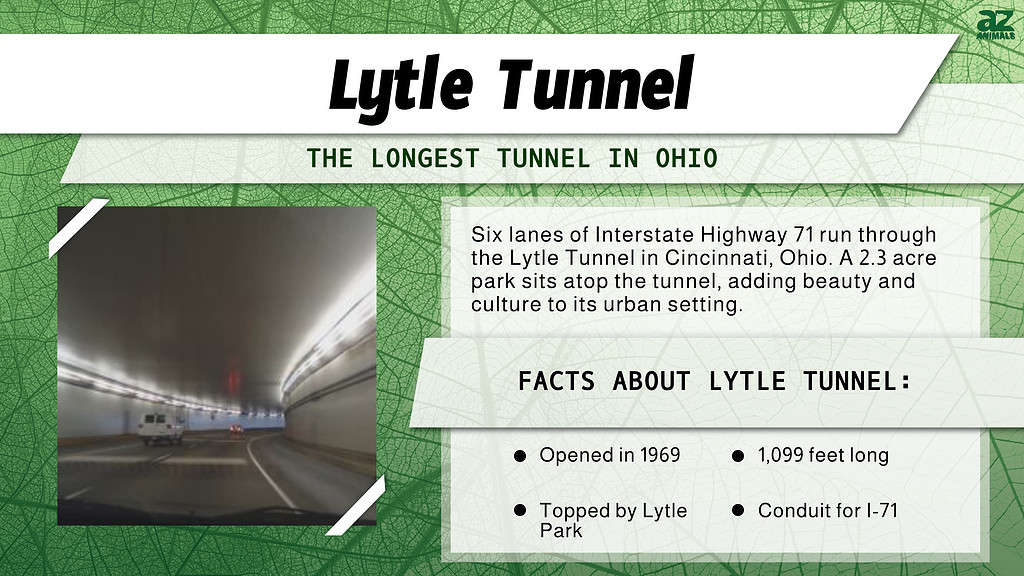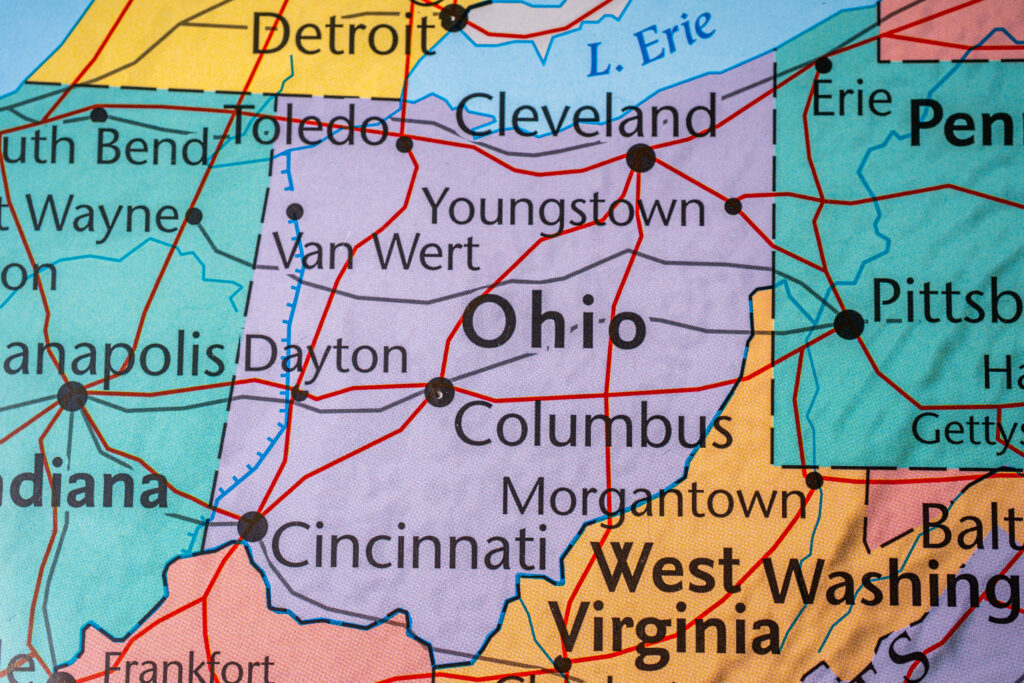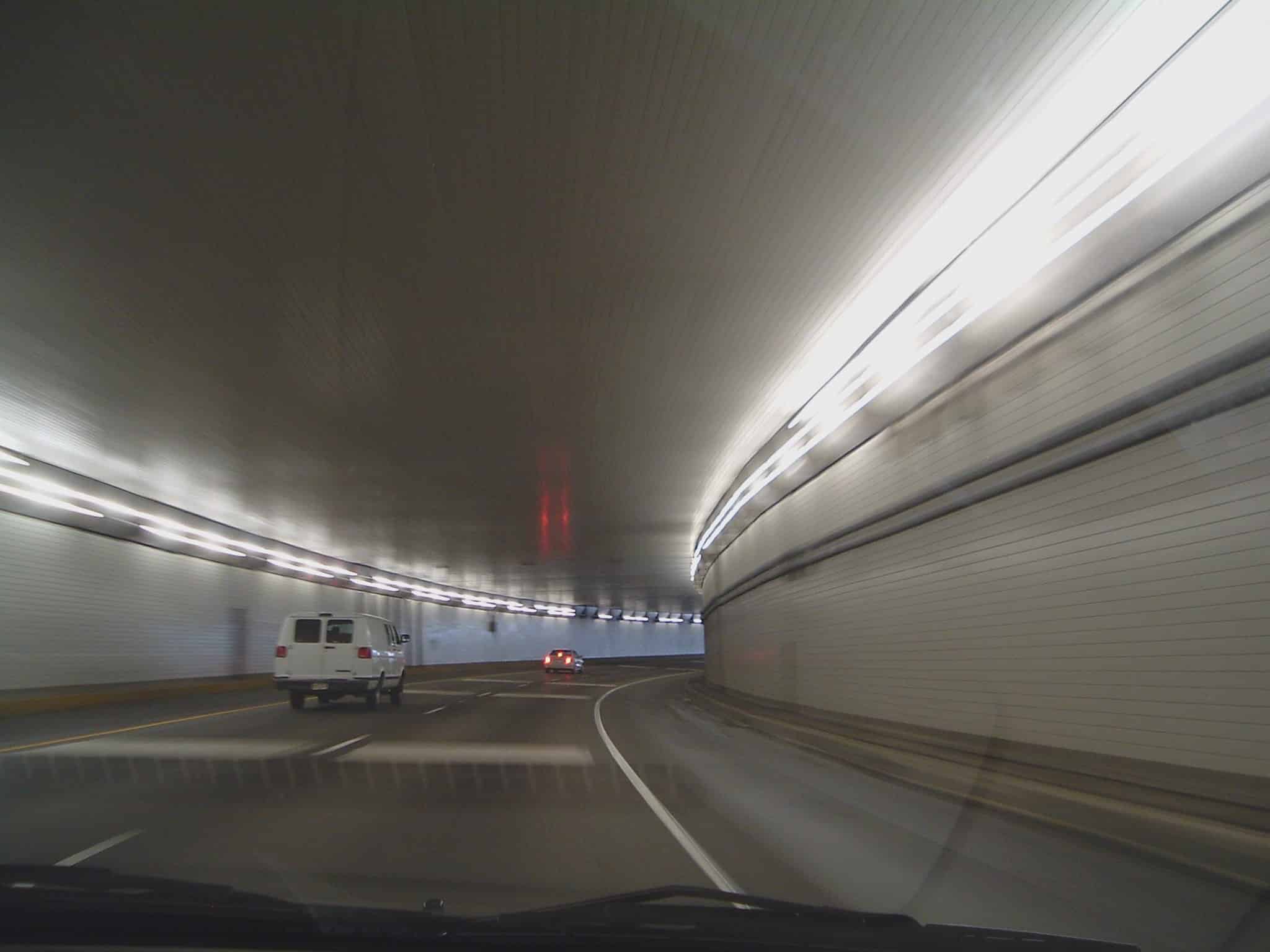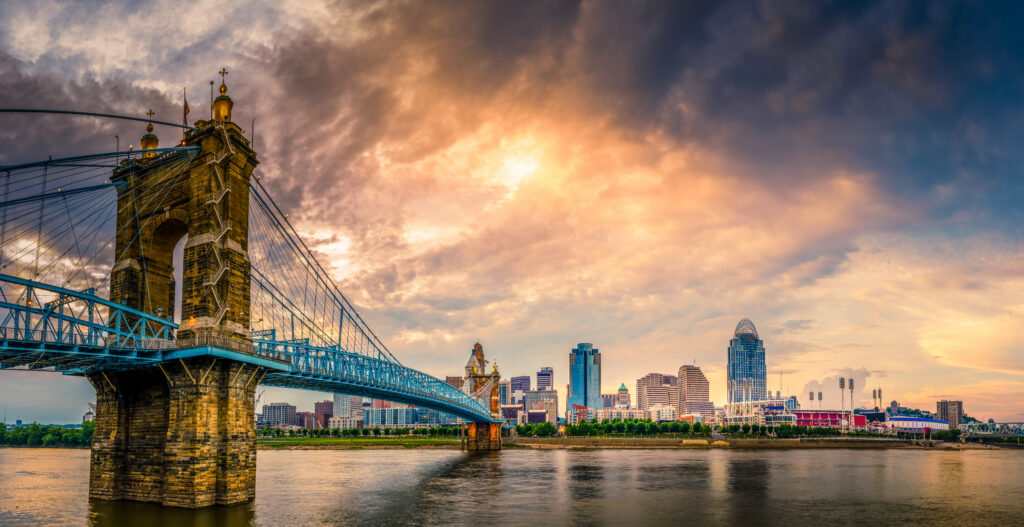
Introduction
Ohio is a state in the Midwest that features a variety of industries, wildlife, natural resources, landscapes, and man-made structures. The longest tunnel in Ohio, located in Cincinnati, stands out because it supports both transportation and recreation. Atop the longest tunnel in Ohio sits a beautiful park with many features that attract residents and visitors of Cincinnati alike. While the tunnel might not appear significant initially, it tells a rich history promoting art, heritage, and natural beauty. Discover the name of the longest tunnel in Ohio and find out what features surround it.
Background on Ohio

Ohio is in the Midwest, bordering Indiana, Pennsylvania, West Virginia, Michigan, and Kentucky.
©Alexander Lukatskiy/Shutterstock.com
Ohio resides in the Midwest region of the United States. It borders Indiana, Kentucky, West Virginia, Pennsylvania, and Michigan and shares a border with Lake Erie. Ohio was the first state from the Northwest Territory accepted into the Union on March 1, 1803. The capital of Ohio is Columbus. The term “Ohio” comes from the Ohio River, which was the Iroquois tribe’s term signifying “great water.”
The state of Ohio includes a diverse assortment of cultures and groups of people. Furthermore, it is a highly industrialized state in and around its major urban centers like Cleveland and Cincinnati. One of Ohio’s greatest contributions to the United States is that it was the birthplace of seven U.S. presidents.
The state has an area measuring 44,826 square miles and a population of 11.8 million as of 2020. Population growth in Ohio is largely due to its location. As the first state in the “West” when traveling from the East Coast, Ohio is the ideal spot for introduction into the Midwest region. Its flat landscape also allows for ease of travel, and its various industries and resources are attractive to many.
The climate in Ohio is like that of the remainder of the North and that of the East. During summer, temperatures never exceed 100ºF, and winter temperatures will reach into the negative teens at most. Average summer temperatures range between the mid-60s and mid-80s. Winter temperature highs measure in the mid-30s and most winter lows sit at about 20ºF. The state sees around 40 inches of rain annually and 28 inches of snowfall. However, the northeastern snowbelt will likely receive over 100 inches of snowfall annually.
The Longest Tunnel in Ohio

The Lytle Tunnel in Cincinnati, Ohio, is part of I-71 and runs underneath Lytle Park.
©Analogue Kid / Analogue Kid at English Wikipedia, Public domain, via Wikimedia Commons
The longest tunnel in Ohio is the Lytle Tunnel on Interstate 71 in Cincinnati, Ohio. Lytle Tunnel was introduced in 1969, measuring 1,099 feet in length. The tunnel receives six lanes of traffic on I-71 and sits underneath Lytle Park in downtown Cincinnati. The tunnel was constructed through private funding, which led to the demolition of the original park above, which was later replaced.
Lytle Tunnel has a humble appearance that subtly complements the urban surroundings. Therefore, a primary aspect that adds to the aesthetic of Lytle Tunnel is the park above it. Lytle Park stretches 2.3 acres. The tunnel and the park received the name “Lytle” from a property previously located where the park and tunnel sit today. The homestead belonged to General William Henry Lytle and was constructed in 1809 before its removal.
Where is Lytle Tunnel Located on the Map?
Lytle Tunnel sits to the north of Newport and Covington on the opposite bank of the Ohio River. It is also located to the far south of the Cincinnati Zoo and Botanical Garden.
Features of Lytle Park
Some features of Lytle Park, which sits above Lytle Tunnel, include horticulture, like tulips and cherry blossom trees that add to the park’s aesthetic quality. Furthermore, a statue of President Abraham Lincoln stands 11 feet tall in the park. Common features of the park include benches, walkways, picnic tables, a playground, and public restrooms. The park allows residents of Cincinnati to enjoy a flavor of nature superimposed against the urban background.
The most fascinating feature of Lytle Park, though, is the Taft Museum of Art. Named for President William Howard Taft’s family, the museum is inside the original Taft historic home. The Taft mansion remains Cincinnati’s oldest wooden residence in the downtown area. The residence was first owned by Martin Baum, who sold it to Nicholas Longworth. Longworth commissioned Robert S. Duncanson to paint eight murals for the home. Duncanson was the first Black American artist to be recognized around the globe, and his murals are considered the most important domestic murals to have been created before the outbreak of the Civil War.
Longworth’s daughter married into the Taft family in the late 1800s, and the family owned the home until 1927. During this year, the family gave their home and art collection to the city of Cincinnati. The home became the Taft Museum of Art five years later, and the mansion became a National Historic Landmark. After a few renovations, the Taft home stands proud in Lytle Park, displaying beautiful works of art, both old and new.
Taft Museum of Art includes a permanent collection of artworks from around the world. The museum also holds rotating exhibitions. Complete with event venues, offices, and dining experiences, the museum is a must-see in Cincinnati. Overall, the museum and the park combine aesthetics and nature with the functionality of the I-71 Lytle Tunnel. Within just over two acres of land, visitors of Cincinnati can experience a valuable synthesis of art, urban planning, and history.
Wildlife Around Lytle Tunnel

The longest tunnel in Ohio is located in Lytle Park, where you can see cardinals and other birds.
©Bonnie Taylor Barry/Shutterstock.com
While wildlife within the urban center of Cincinnati, Ohio, is limited, various types of animals live in abundance just outside the city. For instance, there are over 600,000 white-tail deer in the state of Ohio. White-tail deer are commonly encountered in the Midwest, especially during mating season. Deer typically live in forested areas, bushlands, or meadows. Ohio’s natural landscapes, ranging from dense forests to open fields, are prime examples of ideal habitats for white-tail deer.
Furthermore, Ohio includes approximately 219 kinds of birds within its borders. Ohio’s state bird, the cardinal, has a beautiful red coloration and is often associated with winter and the holiday season. The habitats of cardinals include the edges of forested areas, locations that include bushes and shrubs, and even backyards in suburban neighborhoods. One interesting fact about cardinals is that they don’t participate in winter migration, allowing them to thrive during cold Ohio winter temperatures.
Other animals in Ohio include the eastern dark squirrel, raccoon, American bullfrog, and eastern box turtle. Some fish species found in Ohio waters include rainbow trout, yellow roost, smallmouth bass, and more. One animal, an American favorite, is also found in Ohio. Wild turkeys traverse Ohio habitats like forests and open fields. The wild turkey is well-known for its beautiful plumage and unique mating call.
Other Significant Structures in Ohio

Also located in Cincinnati, The Roebling Bridge is one of the wonders of Ohio and spans across the Ohio River.
©Alexey Stiop/Shutterstock.com
Although Lytle Tunnel in Cincinnati is impressive, other notable structures exist in the state of Ohio. For instance, one of Cincinnati’s most prominent structures is the John A. Roebling Suspension Bridge. The bridge was introduced in 1867 and stretches 1,067 feet long, connecting nearby Covington, Kentucky, to Cincinnati. At the time of its construction, the John A. Roebling Suspension Bridge was the longest bridge on Earth. The bridge is both a National Historic Landmark and a National Historic Civil Engineering Landmark. One unique fact about the bridge is that it services both vehicles and pedestrians wishing to travel across the Ohio River.
In addition, Our Lady, Queen of the Most Holy Rosary Cathedral is a beautiful structure and architectural feat located in Toledo, Ohio. The cathedral opened to the public in 1931 when it held its first mass. The architecture of Our Lady, Queen of the Most Holy Rosary Cathedral drew inspiration from the Spanish Plateresque style. Stretching an impressive 240 feet long and 90 feet high, the cathedral is sure to catch the eye of its beholder.
Finally, Hartman Rock Garden in Springfield, Ohio, is yet another stunning structure to behold. In the 1930s, self-taught artist Harry George “Ben” Hartman built the rock garden, which was filled with over 50 stone or concrete structures, handmade sculptures, and diverse plant species. Many of the structures in Hartman Rock Garden reflect American icons, such as the White House or Independence Hall. These rock formations blend history, popular culture, and more to create an aesthetic and patriotic scene.
The photo featured at the top of this post is © Alexander Lukatskiy/Shutterstock.com
FAQs (Frequently Asked Questions)
What is the longest tunnel in Ohio?
The longest tunnel in Ohio is Lytle Tunnel, located on Interstate 71 in Cincinnati, Ohio.
What are examples of wildlife near Lytle Tunnel?
Wildlife in the Cincinnati region includes white-tail deer, cardinals, wild turkeys, American bullfrogs, rainbow trout, and more.
What are examples of other impressive structures in Ohio?
Some impressive structures in Ohio include the John A. Roebling Suspension Bridge; Our Lady, Queen of the Most Holy Rosary Cathedral; and Hartman Rock Garden.
Thank you for reading! Have some feedback for us? Contact the AZ Animals editorial team.






